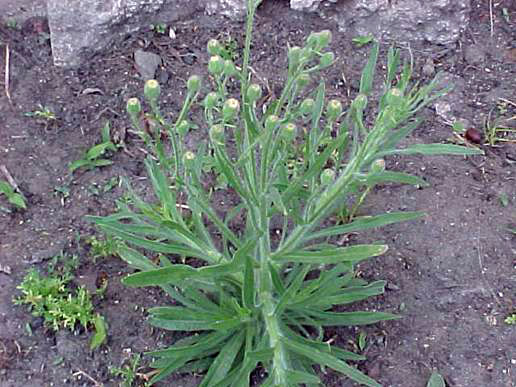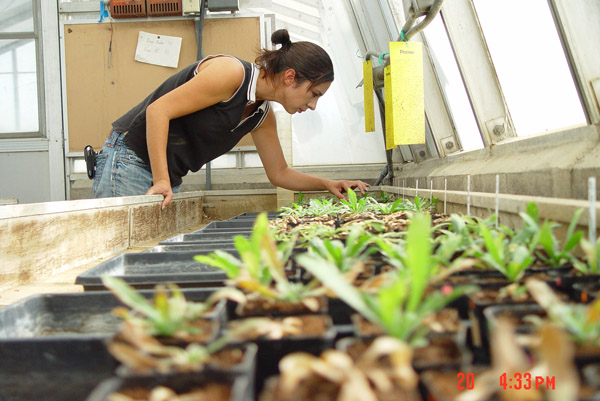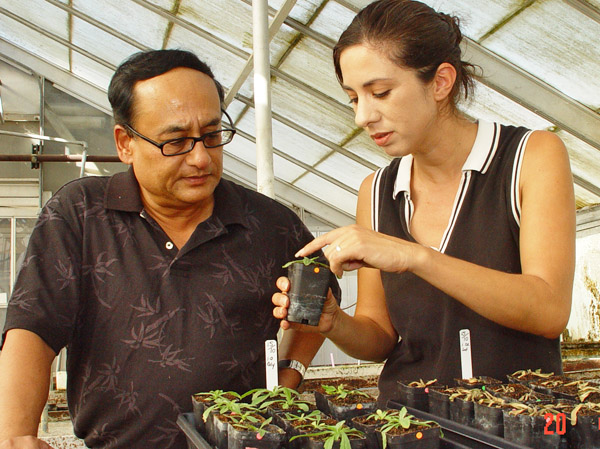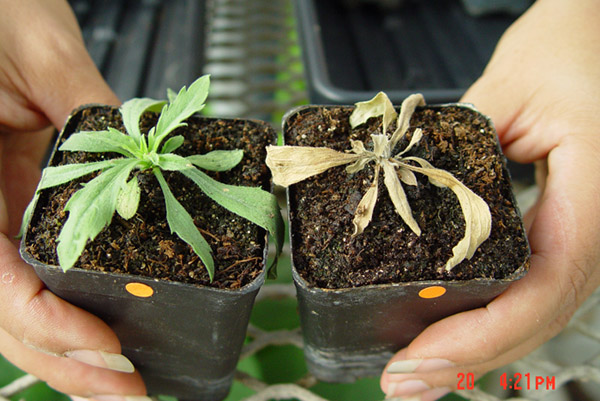California Agricultural Technology Institute
Targeting Hairy Fleabane
Plant scientist supports effort to stop spread of tough weed
 If you are a homeowner and have never seen this weed (see photo at right) in your
lawn or garden – be happy. If you are an agricultural producer and have never seen
this weed in your field, be even happier.
If you are a homeowner and have never seen this weed (see photo at right) in your
lawn or garden – be happy. If you are an agricultural producer and have never seen
this weed in your field, be even happier.
But be warned – hairy fleabane is coming. Populations of the tough plant with a single, thick taproot are spreading and showing resistance to some of the farm industry’s leading herbicides such as glyphosate (key ingredient in Roundup) and paraquat.
In the face of the herb’s advance, a Fresno State plant science specialist is helping growers to fight back.
“Herbicide resistant weeds, particularly glyphosate-resistant ones, are becoming a global problem,” said Professor Anil Shrestha. “In many countries, and in several U.S. states, glyphosate-resistant weeds are threatening the sustainability of agriculture. In particular, hairy fleabane has been confirmed locally in the vineyards and orchards of California.”
 Like most types of weeds, hairy fleabane in an agricultural operation draws irrigation
water away from crops and can also interfere with cultivation or harvest machinery.
Similar in appearance to another common weed called horseweed, Hairy fleabane spreads
rapidly and grows up to three feet tall. Thick stands of the plants can create a virtual
wall of weeds, causing serious problems for farmers.
Like most types of weeds, hairy fleabane in an agricultural operation draws irrigation
water away from crops and can also interfere with cultivation or harvest machinery.
Similar in appearance to another common weed called horseweed, Hairy fleabane spreads
rapidly and grows up to three feet tall. Thick stands of the plants can create a virtual
wall of weeds, causing serious problems for farmers.
According the Shrestha, growers have reported hairy fleabane resistance not only to glyphosate, but to paraquat, another commonly used chemical for weed control.
“Because of this resistance, immediate short-term alternative herbicides were necessary to prevent further spread of these populations,” he said.
Shrestha began conducting greenhouse studies of the weed’s resistance earlier this year along with graduate students Marcelo Moretti and Michelle Dennis using combinations of glyphosate and paraquat, as well as 2,4-D and a newer herbicide called saflufenacil (Treevix), and several others.
The testing featured applications to hairy fleabane plants at different life stages, under different lighting conditions, and at different temperatures.
 One of the first things Shrestha documented was that treated populations of hairy
fleabane showed cross-resistance to both glyphosate and paraquat – bad news.
One of the first things Shrestha documented was that treated populations of hairy
fleabane showed cross-resistance to both glyphosate and paraquat – bad news.
On a positive note, he also found that herbicides such as glufosinate or saflufenacil alone, or glyphosate combined with either 2,4-D or carfentrazone could be used for “fairly successful” control of hairy fleabane.
“These are short-term alternatives, however, and herbicide resistance management in the long run requires a more integrated approach, including furthering knowledge on weed biology and ecology, and other non-chemical control options,” Shrestha said.
Industry interest in his work has been high, Shrestha said. Just half way through his study cycle, he already has received numerous requests from industry groups and other research agencies for details on his findings. The greenhouse studies will continue for another season in order to confirm preliminary results, he said.
 While awaiting more definitive study results, Shrestha is advising growers to take
a more holistic approach to weed control.
While awaiting more definitive study results, Shrestha is advising growers to take
a more holistic approach to weed control.
“We should refrain from the repeated use of the same herbicide because the process creates a selection pressure for evolution of herbicide resistance, and we should also use an integrated weed management program instead or relying on herbicides only for weed control,” he said.
Partial funding for this research was provided by the California State University Agricultural Research Institute (ARI). For more information, contact Shrestha at ashrestha@csufresno.edu.